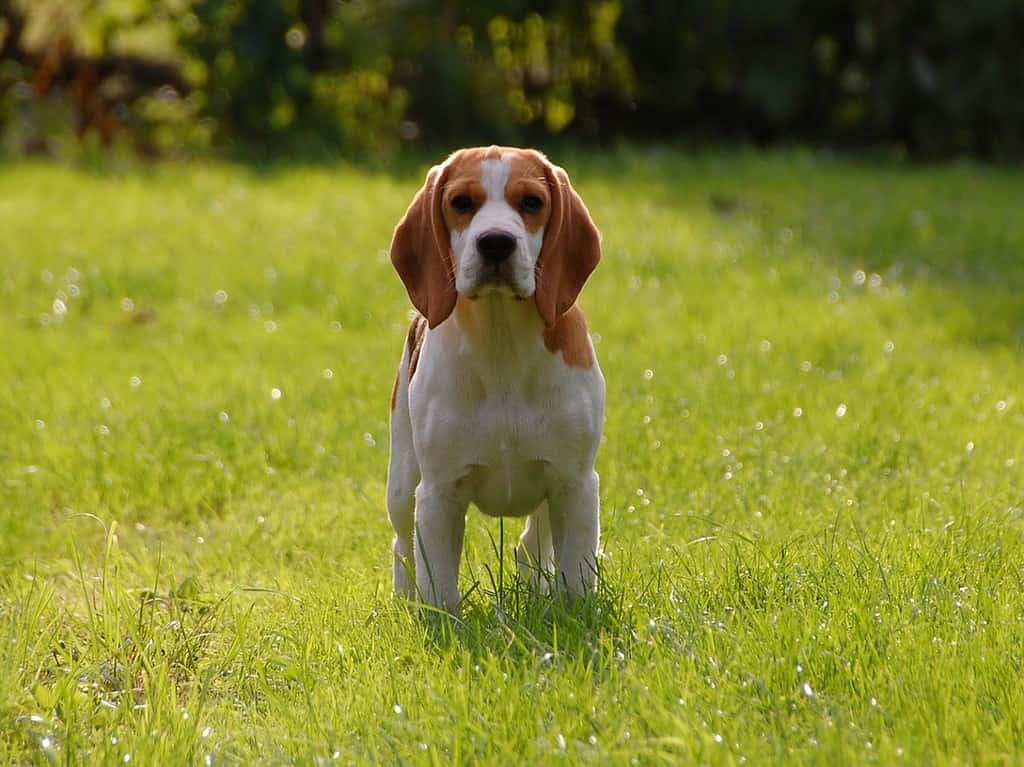Even though your Beagle dogs may tug at your heartstrings with begging eyes, overfeeding them is not a good idea. That’s right; balancing between doting on your dog and providing adequate nutrition for a healthier weight is necessary.
So you want to know — how do I know if my Beagle is overweight?
This guide delves into the essential markers that allow you to identify if your Beagle is packing on too many pounds. We cover physical aspects, like their body shape and mobility, and behavioral signs that could signify your Beagle’s weight gain or obesity.
Equally important: to better understand and prevent weight-related issues in Beagles, we examine the underlying factors that cause weight gain and outline potential health risks associated with obesity.

Overview Of The Beagle Breed
The Beagle is a small or medium breed, bred primarily in England for hunting duties, given its keen sense of smell. This British-bred hound dog was initially bred to pursue small animals such as rabbits and hares. Besides hunting, this breed was employed in various roles, such as search and rescue operations, drug detection tasks, and pest control. These admirable skills have earned Beagles an important place in modern society.
Beagles are known for having cheerful and outgoing personality. Their gentle temperament ensures strong relationships with kids and other animals, making them excellent family companions.
Nevertheless, they are highly energetic dogs that need plenty of activities to ward off boredom. Without appropriate exercise and mental stimulation, Beagles may become restless and bored.
Training and socialization from puppyhood are necessary for Beagles to learn good manners and obedience. Despite their intelligence, they may remain stubborn or independent due to their scent-driven strong instincts. Nevertheless, these tendencies can be managed with patience, consistency, and reward-based reinforcement techniques, making them agreeable companions as they reach adulthood.
The Beagle is generally healthy. Despite that, as with any other dog breed, they are prone to a few health issues, such as hip dysplasia, ear infections, and obesity.
Understanding Beagle Breed Body Type
The Beagle breed has an anatomy specifically adapted to their purpose as a scent hound. Their powerful muscles, proportionate shape, wide chest, and unique head and neck anatomy give them considerable agility, stamina, and scent-tracking capabilities.

One of their defining physical features is their moderately-developed bone structure. Neither too bulky and heavy nor too light and delicate, this characteristic gives them the agility and strength to pursue scents on long hunting trips.
The Beagle has a proportionate body size. Its length and overall height are typically the same, creating a squarish figure. This body structure facilitates quick movement when chasing prey or tracking scents.
The Beagle’s chest is notably deep and wide, which provides them with an impressive lung capacity. This attribute gives the breed a keen sense of smell. That’s why they can detect scents over long distances, and their broad chest can efficiently sustain heavy breathing during such strenuous exercise.
Moreover, the Beaglethe Beagle stands out due to its specific head and neck anatomy, adding to its unique body type that is key in developing its build. Its skull exhibits a moderate length and width with a noticeable transition from forehead to muzzle. The muscular and slightly curved neck plays a crucial role in granting it strength as well as flexibility, thereby enabling them to hold its head up while maintaining balance during its tracking pursuits. These attributes enable the breed’s efficient hunting capabilities.
What Is The Healthy Weight For Beagles
The average weight of an adult Beagle is 20-25 pounds; however, this range may present variations usually considered in lifestyle management for healthy weight. It is essential to routinely evaluate the physical characteristics of the Beagle, i.e., assess it physically to verify whether its body mass is within the ideal parameters or if there is an overweight or underweight problem looming in sight.
How Do I Know If My Beagle Is Overweight
As a Beagle owner, you may wonder: how do I know if my Beagle is overweight? It’s not always easy to tell just by looking at them – some Beagles carry extra weight differently. Here are easy ways to tell if your furry friend needs to shed a few kilos.
Stand back and observe your Beagle’s overall body shape.
The first thing to remember, a healthy Beagle should have a noticeable waist. By standing back and viewing the pup from higher above, it should be evident that there is a subtle curve where the chest ends and hips begin. Should this area be undefined or round, it could signify an overweight condition.
Feel the ribs.
When gently running one’s hands along a Beagle’s ribcage, the tips of fingers should be able to feel the ribs without applying too much pressure. Should a generous layer of fat be felt between the fingertips and ribs, it could indicate that the Beagle carries more than its average weight.
Take a look at your Beagle’s belly from the side.
When looking at your Beagle from the side, notice if there is an even distribution of weight going up towards the back legs; a distinct descent between the torso and hindlegs may indicate that your hound could be carrying extra mass.
Pay attention to your Beagle’s energy levels and activity.
Beagles with overweight tendencies may demonstrate a reduced enthusiasm for activities they usually enjoy, including fetching, running, or socializing with other pets. This lack of motivation to engage in physical activity can be attributed to the increased stress on their joints and energy levels due to excess mass.
Another indication of obesity in Beagles is decreased stamina during walks and treks. If your Beagle tires out quickly or pants heavily and fails to keep up with you during exercise, it could be a sign that it has too much weight.
Pay attention to your Beagle’s breathing.
An elevated rate of respiration or labored breathing can often signify that a Beagle is overweight. If you find your dog panting more than usual during minor physical movements, or if their respiration becomes increasingly louder and rapid, this could mean excess weight placing stress on their respiratory system.
Note: Visual and physical observations are essential to obtain an accurate assessment of a Beagle’s weight, along with weighing the breed on a scale.
Health Risks Associated With Overweight Beagles
Beagles that are overweight risk facing a range of health complications that can adversely affect their lives. Excessive weight puts additional strain on their bodies, and this can manifest in disorders such as arthritis in the joints, leading to pain and mobility issues. This further reduces the quality of life for the dog.

Moreover, overweight Beagles are more prone to developing cardiovascular diseases. The surplus weight strains their hearts, boosting the risk of hypertension, heart issues, and other cardiac-related ailments. Such conditions affect their quality of life negatively and even shorten their lifespan.
Being overweight can also trigger respiratory issues. A buildup of fat in the chest and abdomen restricts their respiratory functions, making it difficult for them to take deep breaths. This difficulty breathing can cause panting, exhaustion, and diminished physical activity or exercise capacity.
Moreover, overweight Beagles may possess a greater predisposition to certain cancers. Research indicates there is a connection between obesity and an increase in bladder, liver, and mammary tumors in dogs. The precise cause behind this connection remains undiscovered, yet it is widely accepted that keeping a balanced weight helps prevent cancer from developing.
Ultimately, when a Beagle is overweight, their immune system may not function properly. Weight gain can compromise the body’s defense mechanisms, increasing the risk of infection and impairing the rate at which wounds heal. Furthermore, this diminished immunity can intensify current medical problems, making it difficult for the pooch to get better from sickness.
Tips for Managing Your Beagle’s Weight
Overconsumption of calories can lead to an unhealthy weight for Beagles. It is essential to adhere to the suggested strategies, which may help facilitate a balanced body weight.
- Create and maintain a regular feeding schedule for Beagles. As they respond favorably to routine, this can help regulate their eating habits and stop them from overconsuming food. Moreover, instead of one big meal daily, divide the daily portion into several smaller portions. Along with helping manage hunger levels, this approach encourages proper digestion and maintains healthy nutrient intake habits.
- Information from your veterinarian should be consulted to ensure a suitable amount of food based on their weight, activity level, and age. However, the quality of the nourishment also matters. The best option is a well-balanced, premium-quality dog food tailored specifically for medium breeds like Beagles, with organic meat as the number one ingredient and minimal artificial additives or fillers included.
- Likewise, you must be conscious about how much treats or table scraps you give your Beagle. While it may be tempting to feed them what people eat, this can quickly lead to an unhealthy and dangerous excess of calories. Stick primarily with low-calorie snacks designed specifically for dogs and use them as occasional treats or training rewards. Some table foods are toxic to dogs and can lead to weight gain if you’re unaware.
- Ensuring your Beagle maintains a healthy weight is imperative; to accomplish this, routine exercise must be incorporated into their daily schedule. Walking, jogging, and light play sessions can physically and mentally engage the dog. Additionally, puzzle toys, interactive feeding devices, or other forms of training can provide stimulation when needed, as this can discourage overeating and destructive behavior that stems from boredom.
- Observe the weight of your Beagle regularly. Weighing them every two weeks can enable you to note any changes in size and pick up on potential weight fluctuations early so that you can address them appropriately. If an increase in mass is observed, it is crucial to seek advice from a vet as soon as possible to investigate the cause and take corrective measures accordingly with diet or activity levels.
- Lastly, monitor your Beagle’s behavior and emotional state. Faced with stress, anxiety, or boredom, some Beagles may find themselves overeating. Offer them a secure and cozy space in your home, multiple toys and chew bones for distraction, and regular attention and care to promote their emotional stability. But if you believe excessive eating is psychological rather than physical, contact an experienced dog trainer to deal with any emotional problems in your pup.
Read also: Can Dogs Eat Potato Skins? Read Before You Feed
Frequently Asked Questions
What are the signs that my Beagle may be overweight?
Various clues may demonstrate that your Beagle is carrying extra weight. Visually, it could appear as though its body has rounded and bulging. Additionally, when you touch its stomach, you may find ribs or the spine challenging to feel due to extra fat. You may also witness a thicker neck than normal and a lack of an abdominal tuck typically observed on healthy Beagles.
Changes in behavior frequently accompany weight gain. Your Beagle may appear less energized, have difficulty with physical movement, and become tired more easily during exercise than usual. In addition, weight gain may cause alterations to their breathing patterns, such as snoring and panting.
Other warning signs of obesity in a Beagle could potentially manifest as frequent food scavenging, food stealing, food begging, and constant hunger.
What are the common causes of weight gain in Beagles?
Beagle breeds tend to eat more than necessary; if their access to food is unlimited, caloric intake can lead to obesity. You should monitor their food intake carefully to avoid this issue.
Failure to engage in appropriate exercise contributes to increased weight among Beagles. Known for their energetic nature, these canines require regular physical activity. If inadequate exercise is provided or the lifestyle remains relatively inactive, the calories consumed will not be burned off, resulting in weight gain.
As Beagles age, their metabolism slows, and they need fewer calories to maintain weight. Failure to adjust the diet accordingly can lead to undesired weight gain. Furthermore, spaying or neutering a Beagle can cause hormonal changes that may also affect its metabolism leading to increased body fat if dietary adjustments are not made.
Are there any specific exercises or activities recommended for weight management in Beagles?
Walk your Beagle for at least 30 minutes a day. Walking regularly can facilitate weight loss and provide mental stimulation for your pet. Furthermore, varying routes can help prevent them from becoming bored.
Activities requiring running, like jogging or fetch, should be incorporated alongside walking. Beagles are agile and enjoy the outdoors, so providing chances to play and run can help maintain an ideal weight. However, ensure they do so in a properly enclosed environment or dog park where they cannot become lost.
When should I consult a veterinarian regarding my Beagle’s weight?
If you have taken active measures for weight management for your Beagle but have not seen the desired outcome. The vet can assess your Beagle’s overall health, evaluate their nutrition and fitness habits, and make necessary modifications to help your Beagle achieve a healthy weight.




